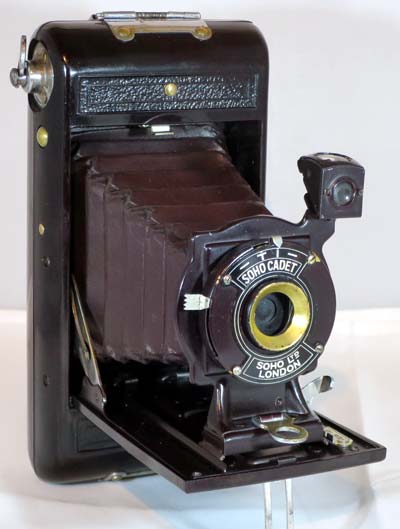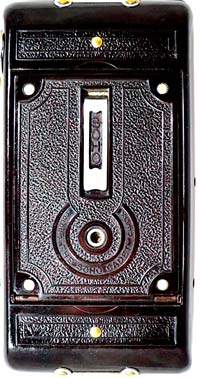Soho Cadet
Specification

| Manufacturer | : | Soho Ltd |
|---|---|---|
| Produced | : | 1930 |
| Classification | : | Medium Format |
| Body Type | : | Folding Bed |
| Bellows Deployment | : | Sliding Rail |
| Construction | : | Red Bakelite |
| Film Type | : | 120 |
| Film Width | : | 62mm |
| Image Size | : | 2¼ x 3¼ |
| No. of Images | : | 8 |
| Lens Type | : | Meniscus |
| Focal Length | : | 95mm |
| Focus Type | : | Fixed |
| Focal Range | : | 6ft - inf. |
| Aperture Type | : | Fixed |
| Apertures | : | f/12 |
| Shutter Type | : | Single Leaf |
| Shutter Speeds | : | T, I*(1/75s) |
| Size Open (w x h x d) | : | 85 x 180 x 118 mm |
| Size Closed (w x h x d) | : | 85 x 180 x 43 mm |
| Weight | : | 530g |
| * Measured on this camera | ||
Art Deco Credentials
![]()
![]()
Acceptable: Modest and restricted
- Produced during the main Art Deco period.
- Decorative dark red Bakelite with tortoiseshell hue.
- Curvilinear moulding on shutter plate.
- Decorative mouldings to Bakelite body with leather-look finish.
- Chrome used on decorative struts.
- Brass & chrome winder.
- Decorative latch.
- Matching brown/maroon bellows.

Description
The Soho company was formed c1926 by F.W.Pettifer and manufactured a large number of cheap box and folding cameras until c1967. Many of its cameras were distributed via premium schemes or mail order catalogues.
The Soho Cadet is a 120 roll film camera sold by Soho Ltd. in London, c.1930. Construction is of dark red/maroon Bakelite, which if you look closely in the light, has faint tortoiseshell markings in it. The colour was described in advertisements as rosewood. The body is complemented with dark maroon leather bellows. The Bakelite body is embossed with a leather type pattern with geometric lines, boxes and circles. It generally has chromed metal struts and fittings but on this camera there are some brass rivets and the lens bezel is painted gold. The camera has a chrome table stand. It is a strut folder but is not self-erecting. It is erected by pulling on a tab and setting the lens in one of two positions - 'NEAR' or 'FAR'. 'FAR' is for normal operation with depth of field to infinity, 'NEAR is for close-ups. It has a brilliant view-finder that swivels for portrait or landscape. Film advance is indicated by red window and is not coupled to shutter.
The Cadet takes 8 6×9cm pictures on 120 film. It has a fixed-focus meniscus lens in an everset shutter with 'I' for Instant and 'T' for timed. In instant mode, the shutter is tripped alternately up/down for each frame. In timed mode the shutter fires with the shutter lever tripped in either direction. The measured shutter speed on this camera is 1/75 seconds which seems a little fast for this age of camera. Not sure what the design speed was but I will continue to research this.
Other versions includes one with a Vario shutter with faster f6.3 Kershaw Anastigmat lens. The Vario shutter has three speeds from 25th to 100th second plus T and B. The aperture Kershaw Anastigmat lens is adjustable from f6.3 to f32. A screw fitting allows a cable release to be fitted. One version had simple changeable Waterhouse stops and in some cases the focus choices were a bit more accurate that 'NEAR' and 'FAR' having positions for 6, 10 and 100 feet.
How to Use
This camera takes 120 film which is widely available.
The aperture is set at about f/12. The measured speed on this camera was 1/75s. As the shutter speed is only 1/75s, it is advisable to use a tripod to get clear shake free images. However, holding it against a wall or other solid object would work as well. For quick snapshots, hold it firmly against your body.
The table shows how this camera will perform using ISO 100/125 film. It is based on the 'Sunny 16' rule. Modern film is so forgiving and will produce acceptable results even when overexposed by 2 or 3 stops or underexposed by 1 stop.
The tables assume that the sun is at least 30 degrees above the horizon - that's 10am - 5pm on a summers day in the UK.
Remember that the exposure guide in the manual may not be helpful as it is based on the use of old film with a low ISO value.
Using ISO 100/125 film - shutter speed 1/75s
| Weather Conditions | Shadow Detail | Aperture | Exposure |
|---|---|---|---|
 Sunny SunnySnow/Sand | Dark with sharp edges | f/12 | +2 Stops Overexposed Acceptable |
 Sunny Sunny | Distinct | f/12 | +1 Stops Overexposed Acceptable |
 Slight Overcast Slight Overcast | Soft around edges | f/12 | Good |
 Overcast Overcast | Barely visible | f/12 | -1 Stop Underexposed Acceptable |
 Heavy Overcast Heavy Overcast | None | f/12 | -2 Stops Underexposed Not Acceptable |
 Open Shade Open Shade/Sunset | None | f/12 | -3 Stops Underexposed Not Acceptable |